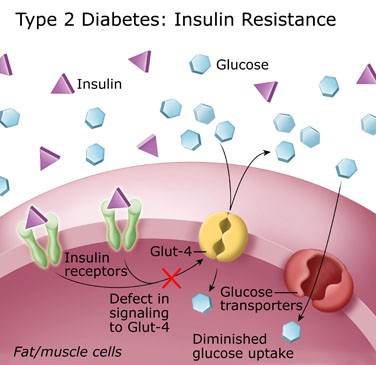Firstly everyone has blood sugar levels but we're really not that interested in them until we are told our levels are high and we have pre-diabetes or maybe even type 2 diabetes. Then all of a sudden our lives seem to run around this process.
Glucose is the sugar that has the leading role in our body providing instant energy so that our muscles move and essential chemical reactions can take place. It is one the three sources of energy in our body: the others are protein and fat.
In an individual without diabetes, very little glucose is actually maintained in
the body and body fluids. A fasting blood sugar test would reveal a result between 4 to 5.5 mg/dl (70 to 100 mmol/l). Without fasting, normal blood sugar levels would be between 4 to 8 mg/dl (70 to 140 mmol/l).
The standard definition of diabetes mellitus is excessive glucose in the blood and is diagnosed using any one of the following:
1. Random plasma glucose greater than or equal to 198 mg/dl (11.1 mmol/l) accompanied by the symptoms of diabetes
2. Fasting plasma glucose greater than or equal to 126 mg/dl (7 mmol/l) and is usually carried out after fasting for eight hours overnight.
3. Blood glucose of greater than or equal to 198 mg/dl (11.1 mmol/l) when tested after swallowing 75 grams of oral glucose (following overnight fasting). This test is known as an Oral Glucose Tolerance Test (OGTT) and is one of the definitive test for diabetes. Although it may not be necessary in diabetics whose random plasma glucose test was greater than or equal to 198 mg/dl (11.1 mmol/l).
Symptoms of Type 2 Diabetes include:
1. Fatigue occurs because your body's cells aren't receiving enough glucose, which is the fuel they need
2. Frequent urination and thirst. Your kidneys attempt to flush out the excessive amounts of sugar and this dehydrates your body and makes you feel thirsty
3. Blurred vision. As your blood sugar levels rise and fall your lenses swell and shrink. Your sight blurs because your eyes cannot adjust quickly enough to these changes.
If you have any of these symptoms do not hesitate to contact your health care provider so he can order one or more of the above tests to determine if your blood sugar levels are within normal ranges, or to screen for type 2 diabetes.
Once you are diagnosed with type 2 diabetes, blood glucose monitoring is the main tool you have to check your diabetes control. By keeping a log you can tell your body's response to your diet, exercise and medication plan. Blood sugar levels show you what works and what doesn't.
Obesity is another symptom present in 90 per cent of people diagnosed with type 2 diabetes. World-wide, levels of obesity are increasing while the amount of physical activity we do is declining. These are the two main lifestyle risk factors for developing type 2 diabetes. Although genetics contributes strongly there is an imbalance between energy in and energy out.
Glucose is the sugar that has the leading role in our body providing instant energy so that our muscles move and essential chemical reactions can take place. It is one the three sources of energy in our body: the others are protein and fat.
In an individual without diabetes, very little glucose is actually maintained in
the body and body fluids. A fasting blood sugar test would reveal a result between 4 to 5.5 mg/dl (70 to 100 mmol/l). Without fasting, normal blood sugar levels would be between 4 to 8 mg/dl (70 to 140 mmol/l).
The standard definition of diabetes mellitus is excessive glucose in the blood and is diagnosed using any one of the following:
1. Random plasma glucose greater than or equal to 198 mg/dl (11.1 mmol/l) accompanied by the symptoms of diabetes
2. Fasting plasma glucose greater than or equal to 126 mg/dl (7 mmol/l) and is usually carried out after fasting for eight hours overnight.
3. Blood glucose of greater than or equal to 198 mg/dl (11.1 mmol/l) when tested after swallowing 75 grams of oral glucose (following overnight fasting). This test is known as an Oral Glucose Tolerance Test (OGTT) and is one of the definitive test for diabetes. Although it may not be necessary in diabetics whose random plasma glucose test was greater than or equal to 198 mg/dl (11.1 mmol/l).
Symptoms of Type 2 Diabetes include:
1. Fatigue occurs because your body's cells aren't receiving enough glucose, which is the fuel they need
2. Frequent urination and thirst. Your kidneys attempt to flush out the excessive amounts of sugar and this dehydrates your body and makes you feel thirsty
3. Blurred vision. As your blood sugar levels rise and fall your lenses swell and shrink. Your sight blurs because your eyes cannot adjust quickly enough to these changes.
If you have any of these symptoms do not hesitate to contact your health care provider so he can order one or more of the above tests to determine if your blood sugar levels are within normal ranges, or to screen for type 2 diabetes.
Once you are diagnosed with type 2 diabetes, blood glucose monitoring is the main tool you have to check your diabetes control. By keeping a log you can tell your body's response to your diet, exercise and medication plan. Blood sugar levels show you what works and what doesn't.





0 comments:
Post a Comment